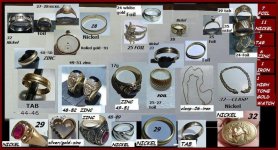What numbers does most of the gold show up on?
I post this pic every time anyone asks this question.
A picture is worth a thousand words, sometimes, but those are not Nox numbers.
Very tiny pieces like earring studs and thin chains can easily be in iron at 0 or even below.
Other slightly larger pieces above 0 through all the numbers up into foil.
I have dug a lot of women's rings that are usually smaller and can come in all the numbers of foil.
Larger rings, men's usually, can enter the nickel range and all the numbers surrounding that range.
Even bigger pieces get up into tabs and all those numbers.
Because the larger nickel and tab area pieces tend to be nice, solid signals more of those are found by hunters so I am sure you will read advice from hunters to find gold you have to concentrate on those two areas because that is where gold is found, sure, a lot of them do but not all of them by any means so this is not correct and those that do will miss gold at foil if that is all they do.
Now bigger gold, like 9, 10 grams and bigger men's gold school rings...I hate to say it but those tend to behave like they are a zinc cent and can show up at all zinc numbers, above and below.
If you are lucky enough to pass your coil over a large, pure gold coin like a $20 piece you might think it is a high to be coin like a quarter, half of silver dollar.
Are you getting it?
Gold can come in just about anywhere depending on the size, shape and purity and I mean anywhere.
Add to that you have other things that affect our "gold" signals.
If you scan a ring that is crushed or even just broken that screws up the signal we would usually get if the piece was in perfect condition and usually lowers the signal into other areas.
Chains, those are weird no matter what and detectors aren't really designed to find them or even notice them...be they gold, silver or whatever else.
They can be found but things have to line up for you to do it and some skills and behavior knowledge searching g for them really helps.
Oh yea, dirt and ground conditions also affect our signals.
Mineralization, trash or iron in the vicinity of gold can screw up everything, too, masking can be a huge issue when looking for gold in high trash areas and high trash areas is where I usually look for them because high trash means more people and more lost jewelry.
Since you are new this is what I suggest...
Forget going after iron area gold, those are rare and you will kill yourself digging up junk.
Foil gold can be tricky, not always solid but if you learn to hunt with less discrimination but train yourself to notice the more solid signals if and when they pop up you might get lucky.
Same with nickel, tabs and zinc...everyone advises newbies to dig everything at first which is the best and fastest way to learn detectors and this hobby but you asked about gold specifically so you need to learn how that metal behaves and how your detector reacts to it.
Like anything else that just takes practice.
All the gold I have dug came in solid, not all of it does but mine did so I dig all solid signals always...no matter where they are.
Hunt with less disc, confusing at first but you will have a better shot at more gold if you can do it and much more than just gold if you can master it.
Dig the solid signals if nothing else, always dig the solid signals.
Learn more about your detector, gold hunting is either luck or a specialty skill that you learn AFTER you understand your detector.
Good luck.



